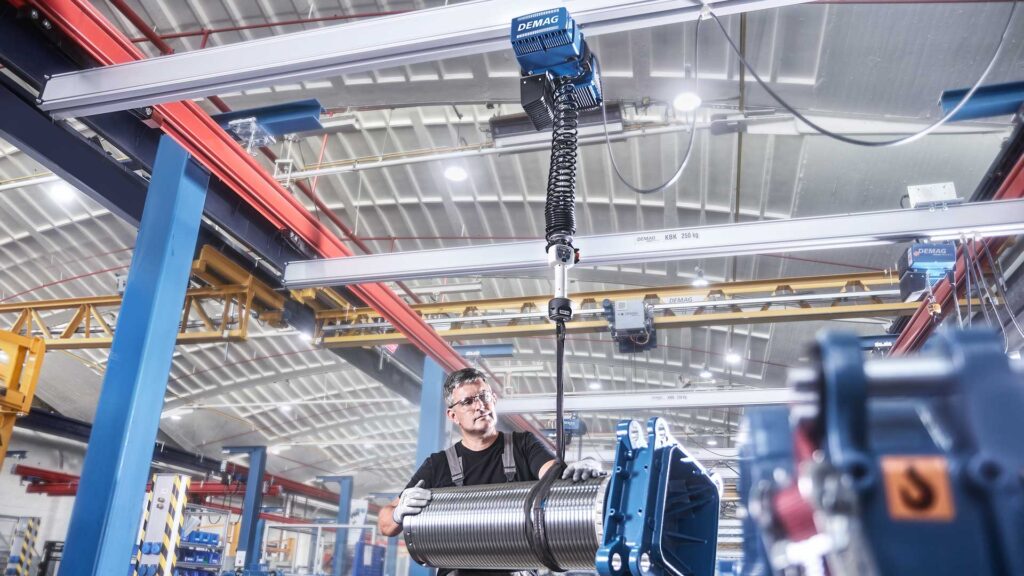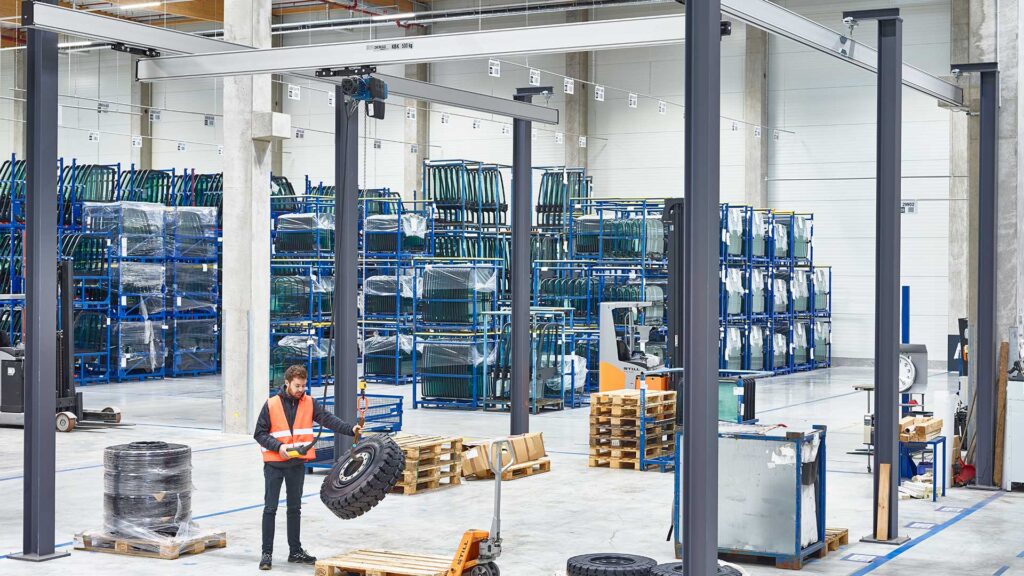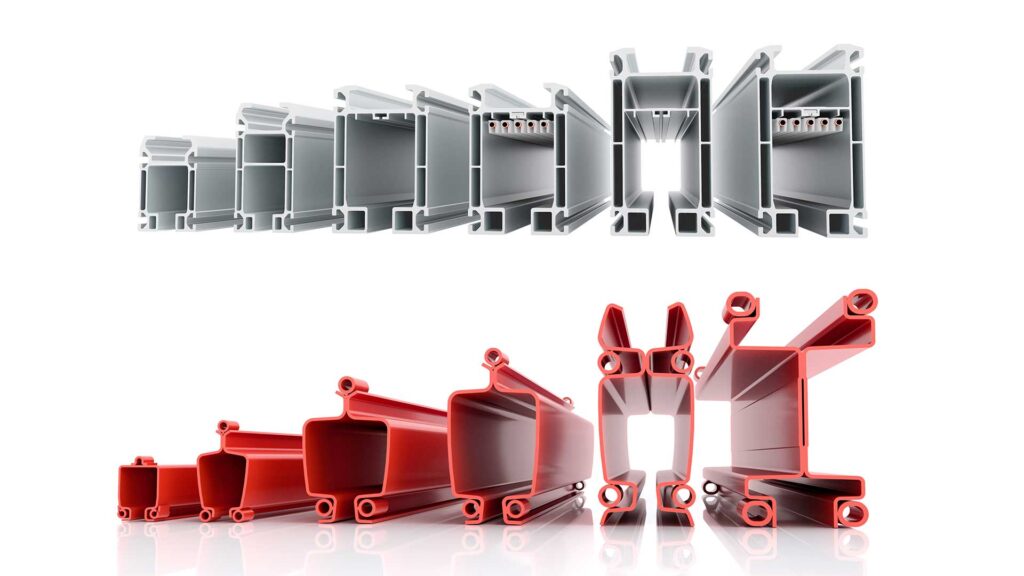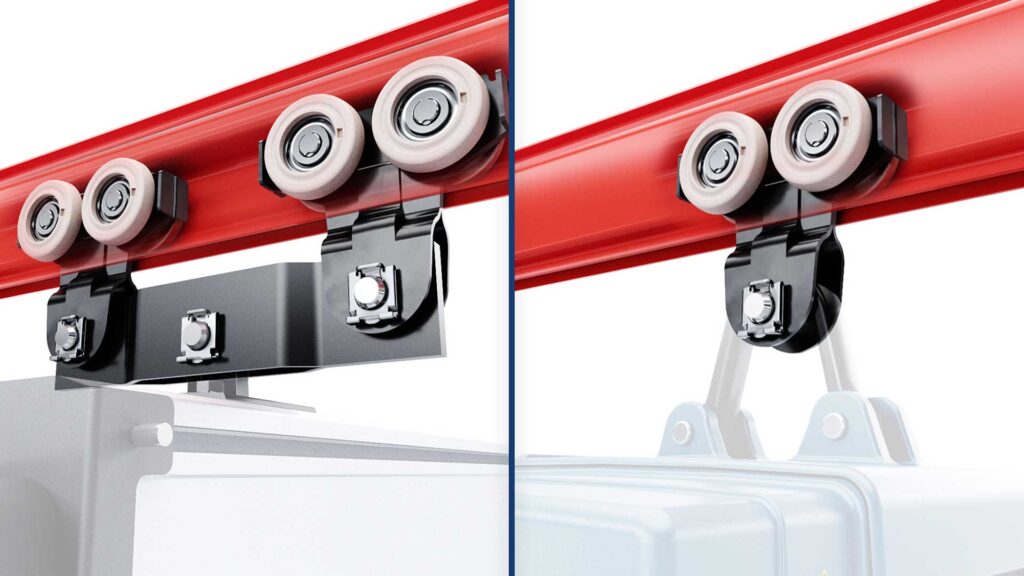Ergonomics plays a crucial role in ensuring safe and efficient overhead lifting operations and material handling in various industries. The Occupational Safety and Health Administration (OSHA) and other relevant safety organizations recognize the significance of ergonomics in preventing workplace injuries, specifically those related to musculoskeletal disorders (MSDs).
It is critical that lifting and material handling processes are ergonomic to help reduce the high costs of injury to your workforce. Employing ergonomic products can help you meet this critical KPI. In this post, we talk about the importance of ergonomic lifting, proper training, and the advanced ergonomic benefits of Demag KBK Modular Cranes.

Importance of Ergonomics in Material Handling
OSHA (the Occupational Safety and Health Administration) emphasizes the importance of ergonomics in ensuring the safety of overhead lifting operations. Their guidelines highlight the need for proper lifting techniques, equipment design, and work practices to reduce the risk of injuries. Overhead lifting operations, especially those involving heavy loads, place significant strain on workers’ bodies, leading to MSDs such as strains, sprains, and back injuries. Ergonomic considerations, such as proper lifting techniques, equipment design, and training, can help minimize these risks.
Repetitive strain injuries and musculoskeletal disorders are a common and costly occupational health problem. According to OSHA, work-related musculoskeletal disorders alone account for approximately one-third of all occupational injuries and illnesses, resulting in significant costs in terms of medical expenses, lost productivity, and workers’ compensation. Ergonomics help fit the job to the worker. Companies that focus on making a job ergonomic can help reduce the high costs of MSDs for their workforce and increasing productivity.
Lifting Equipment Designed for Ergonomics
Manual lifting of heavy materials is a common cause of workplace injuries. Ergonomics aims to reduce the need for manual lifting by promoting the use of mechanized equipment, such as chain hoists and enclosed rail crane systems. These tools allow for more efficient and safer material handling, minimizing the risk of injuries associated with manual lifting.

Ergonomics focuses on optimizing workstation design to facilitate proper body mechanics and minimize unnecessary movements. Ergonomic considerations reduce the need for awkward postures and repetitive motions during material handling activities.
Basic Ergonomics of Demag KBK Crane Systems
Enclosed rail crane systems can make lifting and handling loads more ergonomic for your workforce. A workstation crane system can be designed and tailored to complement and properly assist operators and processes. Demag KBK Modular Crane Systems are designed with ergonomic use in mind.

Both steel and aluminum track are coated inside and outside ensuring the external profile and internal running surfaces are protected from corrosion. The smooth powder coated surfaces of the KBK steel track and smooth anodized surfaces of Demag Aluline track provide smooth, long term ergonomic performance.

Paired with the coated surfaces of KBK track, low rolling resistance trolleys for bridges and lifting devices optimize ergonomic performance in manual push/pull applications. Trolley travel feels smooth as the operator pushes or pulls with quiet operation.
KBK is designed for easy installation and adjustability. Installing track requires no drilling or welding to the support structure. Track hangers make adjusting the height of the system easy. Both the track hangers and crane eyes articulate for the ultimate in ergonomic performance.
Articulation for the Best Ergonomic Performance
The key articulating components of KBK are the track suspension hanger and crane eye. The articulating track suspension hanger has a ball head to allow for 360-degree motion. The crane suspension eye articulates in a similar motion. The articulation of the track hangers and crane eyes work together to allow the crane bridge to skew, meaning the two ends of the bridge do not stay parallel.
Both of these articulating components allow the crane bridge to move side to side and skew up to 12 degrees. As the bridge skews, reduces binding and greatly reduces the effort of the operator when staring, moving, and stopping the load in the precise location needed.
Your workforce may be used to using a rigid system where binding is an issue. The ergonomic performance of a rigid system gets progressively worse as the load gets closer to toward the ends of the bridge. Unlike rigid systems, an articulating system ensures the crane moves easily, giving ergonomic handling and performance throughout the entire system and especially near the ends of the bridge. If your system requires long bridges, an articulating system will greatly improve the ergonomics on the ends of the bridge compared to a rigid system.
Proper Training
Ergonomic training and education programs are vital for workers involved in material handling operations. Such programs help employees understand proper lifting techniques, equipment usage, and the importance of ergonomics in preventing injuries. OSHA encourages employers to provide training to ensure workers are equipped with the necessary knowledge and skills to perform their tasks safely.
Creating an ergonomic working environment for your workforce is a critical KPI. Repetitive strain injuries and MSDs cost employers millions each year. Making the job more ergonomic can help reduce the high costs and increase productivity.
When evaluating the ergonomics of your lifting and material handling processes, look for equipment purpose built and designed to make lifting and material handling more ergonomic for your workforce. Demag KBK Crane Systems are designed to be ergonomic for lifting operations. They offer the best ergonomic performance to prevent binding, articulating to make tasks at the ends of the bridge ergonomic.
Learn more about Demag KBK Crane Systems and contact us to discuss your challenges.
